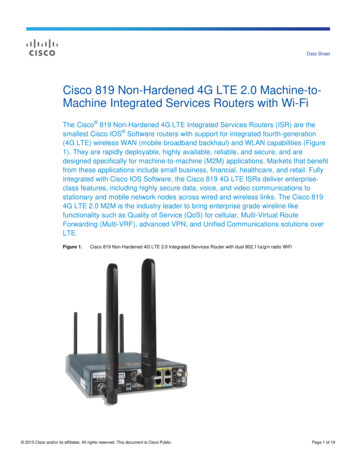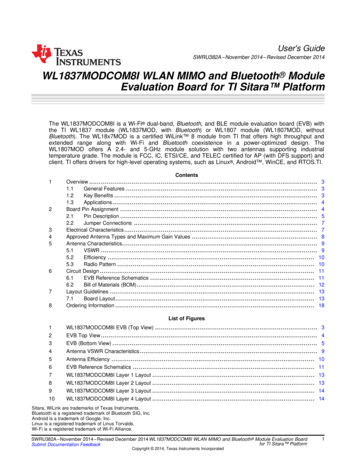
Transcription
User's GuideSWRU382A – November 2014 – Revised December 2014WL1837MODCOM8I WLAN MIMO and Bluetooth ModuleEvaluation Board for TI Sitara PlatformThe WL1837MODCOM8I is a Wi-Fi dual-band, Bluetooth, and BLE module evaluation board (EVB) withthe TI WL1837 module (WL1837MOD, with Bluetooth) or WL1807 module (WL1807MOD, withoutBluetooth). The WL18x7MOD is a certified WiLink 8 module from TI that offers high throughput andextended range along with Wi-Fi and Bluetooth coexistence in a power-optimized design. TheWL1807MOD offers A 2.4- and 5-GHz module solution with two antennas supporting industrialtemperature grade. The module is FCC, IC, ETSI/CE, and TELEC certified for AP (with DFS support) andclient. TI offers drivers for high-level operating systems, such as Linux , Android , WinCE, and RTOS.TI.12345678ContentsOverview . 31.1General Features . 31.2Key Benefits . 31.3Applications . 4Board Pin Assignment . 42.1Pin Description . 52.2Jumper Connections . 7Electrical Characteristics . 7Approved Antenna Types and Maximum Gain Values . 8Antenna Characteristics. 95.1VSWR . 95.2Efficiency . 105.3Radio Pattern . 10Circuit Design . 116.1EVB Reference Schematics . 116.2Bill of Materials (BOM) . 12Layout Guidelines . 137.1Board Layout . 13Ordering Information . 18List of Figures1WL1837MODCOM8I EVB (Top View) . 32EVB Top View . 43EVB (Bottom View) . 54Antenna VSWR Characteristics . 95Antenna Efficiency106EVB Reference Schematics1178910.WL1837MODCOM8I Layer 1 Layout .WL1837MODCOM8I Layer 2 Layout .WL1837MODCOM8I Layer 3 Layout .WL1837MODCOM8I Layer 4 Layout .13131414Sitara, WiLink are trademarks of Texas Instruments.Bluetooth is a registered trademark of Bluetooth SIG, Inc.Android is a trademark of Google, Inc.Linux is a registered trademark of Linus Torvalds.Wi-Fi is a registered trademark of Wi-Fi Alliance.SWRU382A – November 2014 – Revised December 2014 WL1837MODCOM8I WLAN MIMO and Bluetooth Module Evaluation Boardfor TI Sitara PlatformSubmit Documentation FeedbackCopyright 2014, Texas Instruments Incorporated1
www.ti.com11Module Layout Guidelines (Top Layer) . 1512Module Layout Guidelines (Bottom Layer) . 1513Trace Design for the PCB Layout . 1614Layer 1 Combined With Layer 2. 1615Top Layer – Antenna and RF Trace Routing Layout Guidelines16Bottom Layer – Antenna and RF Trace Routing Layout Guidelines. 1717MIMO Antenna Spacing . 18.17List of Tables1Pin Description . 52Approved Antenna Types and Maximum Gain Values . 83BOM . 124Module Layout Guidelines5.Antenna and RF Trace Routing Layout Guidelines .1517WarningThe WL1837MODCOM8I board is tested to comply with ETSI/R&TTE over temperatures from –40 C to 85 C.This board should not be modified to operate in other frequency bands other than what they are designedfor.FCC Licensing Requirements for the Wi-Fi and Bluetooth Radio Module of the EVM:For evaluation only; not FCC approved for resale. This kit is designed to allow:1. Product developers to evaluate electronic components, circuitry, or software associated with the kit todetermine whether to incorporate such items in a finished product2. Software developers to write software applications for use with the end product. This kit is not afinished product and when assembled may not be resold or otherwise marketed unless all requiredFCC equipment authorizations are first obtained. Operation is subject to the condition that this productnot cause harmful interference to licensed radio stations and that this product accept harmfulinterference. Unless the assembled kit is designed to operate under part 15, part 18, or part 95 of thischapter, the operator of the kit must operate under the authority of an FCC license holder or mustsecure an experimental authorization under part 5 of this chapter.Per TI’s Regulatory Compliance Information located in the WL1837MODCOM8I User’s Guide’s“Evaluation Board/Kit/Module (EVM) Additional Terms,” this EVM cannot be used for production purposesand is explicitly restricted from end-product introduction.Use of this EVM requires the developer to provide a minimum distance of at least 20 cm from the antennato all persons in order to minimize risk of potential radiation hazards.CAUTIONDo not leave the EVM powered when unattended.2WL1837MODCOM8I WLAN MIMO and Bluetooth Module Evaluation BoardSWRU382A – November 2014 – Revised December 2014for TI Sitara PlatformSubmit Documentation FeedbackCopyright 2014, Texas Instruments Incorporated
Overviewwww.ti.com1OverviewFigure 1 shows the WL1837MODCOM8I EVB.U1WL1837MODGIFigure 1. WL1837MODCOM8I EVB (Top View)1.1General FeaturesThe WL1837MODCOM8I EVB includes the following features: WLAN, Bluetooth, and BLE on a single module board 100-pin board card Dimensions: 76.0 mm (L) x 31.0 mm (W) WLAN 2.4- and 5-GHz SISO (20- and 40-MHz channels), 2.4-GHz MIMO (20-MHz channels) Support for BLE dual mode Seamless integration with TI Sitara and other application processors Design for the TI AM335X general-purpose evaluation module (EVM) WLAN and Bluetooth, BLE, and ANT cores that are software- and hardware-compatible with priorWL127x, WL128x, and BL6450 offerings for smooth migration to device Shared host-controller-interface (HCI) transport for Bluetooth, BLE, and ANT using UART and SDIO forWLAN Wi-Fi and Bluetooth single-antenna coexistence Built-in chip antenna Optional U.FL RF connector for external antenna Direct connection to the battery using an external switched-mode power supply (SMPS) supporting2.9- to 4.8-V operation VIO in the 1.8-V domain1.2Key BenefitsThe WL18x7MOD offers the following benefits: Reduces design overhead: Single WiLink 8 module scales across Wi-Fi and Bluetooth WLAN high throughput: 80 Mbps (TCP), 100 Mbps (UDP) Bluetooth 4.1 BLE (Smart Ready) Wi-Fi and Bluetooth single-antenna coexistence Low power at 30% to 50% less than the previous generation Available as an easy-to-use FCC-, ETSI-, and Telec-certified moduleSWRU382A – November 2014 – Revised December 2014 WL1837MODCOM8I WLAN MIMO and Bluetooth Module Evaluation Boardfor TI Sitara PlatformSubmit Documentation FeedbackCopyright 2014, Texas Instruments Incorporated3
Overview 1.3www.ti.comLower manufacturing costs saves board space and minimizes RF expertise.AM335x Linux and Android reference platform accelerates customer development and time to market.ApplicationsThe WL1837MODCOM8I device is designed for the following applications: Portable consumer devices Home electronics Home appliances and white goods Industrial and home automation Smart gateway and metering Video conferencing Video camera and security2Board Pin AssignmentFigure 2 shows the top view of the EVB.Figure 2. EVB Top View4WL1837MODCOM8I WLAN MIMO and Bluetooth Module Evaluation BoardSWRU382A – November 2014 – Revised December 2014for TI Sitara PlatformSubmit Documentation FeedbackCopyright 2014, Texas Instruments Incorporated
Board Pin Assignmentwww.ti.comFigure 3 shows the bottom view of the EVB.Figure 3. EVB (Bottom View)2.1Pin DescriptionTable 1 describes the board pins.Table 1. Pin DescriptionNo.NameTypeDescription1SLOW CLKISlow clock input option (default: NU)2GNDGGround3GNDGGround4WL ENIWLAN enable5VBATP3.6-V typical voltage input6GNDGGround7VBATP3.6-V typical voltage input8VIOPVIO 1.8-V (I/O voltage) input9GNDGGround10N.C.11WL RS232 TX12N.C.13WL RS232 RX14N.C.15WL UART DBG16N.C.17N.C.18GNDGGround19GNDGGround20SDIO CLKIWLAN SDIO clockNo connectionOWLAN tool RS232 outputNo connectionIWLAN tool RS232 inputNo connectionOWLAN Logger outputNo connectionNo connectionSWRU382A – November 2014 – Revised December 2014 WL1837MODCOM8I WLAN MIMO and Bluetooth Module Evaluation Board forTI Sitara PlatformSubmit Documentation FeedbackCopyright 2014, Texas Instruments Incorporated5
Board Pin Assignmentwww.ti.comTable 1. Pin Description (continued)No.6NameTypeDescription21N.C.No connection22GND23N.C.24SDIO CMD25N.C.26SDIO D027N.C.28SDIO D129N.C.30SDIO D231N.C.32SDIO D333N.C.34WLAN IRQ35N.C.36N.C.37GND38N.C.No connection39N.C.No connection40N.C.No connection41N.C.No connection42GND43N.C.No connection44N.C.No connection45N.C.No connection46N.C.47GND48N.C.No connection49N.C.No connection50N.C.No connection51N.C.No connection52PCM IF CLK53N.C.54PCM IF FSYNC55N.C.56PCM IF DIN57N.C.58PCM IF d65N.C.66BT UART IF TX67N.C.GGroundNo connectionI/OWLAN SDIO commandNo connectionI/OWLAN SDIO data bit 0No connectionI/OWLAN SDIO data bit 1No connectionI/OWLAN SDIO data bit 2No connectionI/OWLAN SDIO data bit 3No connectionOWLAN SDIO interrupt outNo connectionNo connectionGGGroundGroundNo connectionGI/OGroundBluetooth PCM clock input or outputNo connectionI/OBluetooth PCM frame sync input or outputNo connectionIBluetooth PCM data inputNo connectionOBluetooth PCM data outputNo connectionGGroundNo connectionNo connectionNo connectionOBluetooth HCI UART transmit outputNo connectionWL1837MODCOM8I WLAN MIMO and Bluetooth Module Evaluation Board for SWRU382A – November 2014 – Revised December 2014TI Sitara PlatformSubmit Documentation FeedbackCopyright 2014, Texas Instruments Incorporated
Board Pin Assignmentwww.ti.comTable 1. Pin Description (continued)No.2.2NameTypeIDescription68BT UART IF RXBluetooth HCI UART receive input69N.C.70BT UART IF CTS71N.C.72BT UART IF RTS73N.C.74RESERVED175N.C.76BT UART DEBUGOBluetooth Logger UART output77GNDGGround78GPIO9I/OGeneral-purpose I/O79N.C.No connection80N.C.No connection81N.C.No connection82N.C.No connection83GND84N.C.No connection85N.C.No connection86N.C.87GND88N.C.89BT C.95GNDGGround96GPIO11I/OGeneral-purpose I/O97GNDGGround98GPIO12I/OGeneral-purpose I/O99TCXO CLK COM100GPIO10No connectionIBluetooth HCI UART Clear-to-Send inputNo connectionOBluetooth HCI UART Request-to-Send outputNo connectionOReservedNo connectionGGroundNo connectionGGroundNo connectionIBluetooth enableNo connectionNo connectionNo connectionII/OOption to supply 26 MHz externallyGeneral-purpose I/OJumper ConnectionsThe WL1837MODCOM8I EVB includes the following jumper connections: J1: Jumper connector for VIO power input J3: Jumper connector for VBAT power input J5: RF connector for 2.4- and 5-GHz WLAN and Bluetooth J6: Second RF connector for 2.4-GHz WLAN3Electrical CharacteristicsFor electrical characteristics, see the WL18xxMOD WiLink Single-Band Combo Module – Wi-Fi ,Bluetooth , and Bluetooth Low Energy (BLE) Data Sheet (SWRS170).SWRU382A – November 2014 – Revised December 2014 WL1837MODCOM8I WLAN MIMO and Bluetooth Module Evaluation Boardfor TI Sitara PlatformSubmit Documentation FeedbackCopyright 2014, Texas Instruments Incorporated7
Approved Antenna Types and Maximum Gain Values4www.ti.comApproved Antenna Types and Maximum Gain ValuesThis device is intended only for OEM integrators under the following conditions: The antenna must be installed so that 20 cm is maintained between the antenna and users. The transmitter module cannot be co-located with any other transmitter or antenna. The radio transmitter can operate only using an antenna of a type and maximum (or lesser) gainapproved by TI. Table 2 lists the antennas approved by TI for use with the radio transmitter along withmaximum allowable gain values. Antenna types not included in the list or having a gain greater thanthe maximum indicated are strictly prohibited for use with this transmitter.Table 2. Approved Antenna Types and Maximum Gain Values(1)Antenna TypeBrand2.4 GHz4.9 to 5.9 GHz DK2.273.96UnitdBiRange is approximate.NOTE: If these conditions cannot be met (for example, with certain laptop configurations or colocation with another transmitter), the FCC/IC authorization will not be considered valid andthe FCC ID/IC ID cannot be used on the final product. In these circumstances, the OEMintegrator is responsible for reevaluating the end product (including the transmitter) andobtaining a separate FCC/IC authorization.8WL1837MODCOM8I WLAN MIMO and Bluetooth Module Evaluation BoardSWRU382A – November 2014 – Revised December 2014for TI Sitara PlatformSubmit Documentation FeedbackCopyright 2014, Texas Instruments Incorporated
Antenna Characteristicswww.ti.com5Antenna Characteristics5.1VSWRFigure 4 shows the antenna VSWR characteristics.Figure 4. Antenna VSWR CharacteristicsSWRU382A – November 2014 – Revised December 2014 WL1837MODCOM8I WLAN MIMO and Bluetooth Module Evaluation Boardfor TI Sitara PlatformSubmit Documentation FeedbackCopyright 2014, Texas Instruments Incorporated9
Antenna Characteristics5.2www.ti.comEfficiencyFigure 5 shows the antenna efficiency.Figure 5. Antenna Efficiency5.3Radio PatternFor information on the antenna radio pattern and other related information, 37MODCOM8I WLAN MIMO and Bluetooth Module Evaluation BoardSWRU382A – November 2014 – Revised December 2014for TI Sitara PlatformSubmit Documentation FeedbackCopyright 2014, Texas Instruments Incorporated
Circuit Designwww.ti.com6Circuit Design6.1EVB Reference SchematicsFigure 6 shows the reference schematics for the EVB.WL UART DBGR10R 0402R20R 0402R4BT UART DBGJ1NU HEADER 1x2H-1X2 2MM0R 0402R321BT EN SOCTP21TP11C210uF0603C11uF0402R320R0603VBAT IN1TP7VIO IN0R 0402R310R0603C30.1uF0402SLOW CLKOSC11V8 / 32.768kHzOSC-3.2X2.5SLOW CLK21WLAN EN SOC3R60R04022OUTGNDVIO INVBAT IN1EN4VCCC40.1uF0402J3NU HEADER 1x2H-1X2 2MMWL RS232 TXWL RS232 RXA2ENGNDA13433GNDGNDGND35363738VIOGNDEXT 32K41424039GNDBT EN SOCWLAN EN SOC4643BT UART DBGWL UART DBGGND474445GNDVBATRF DGNDGNDGNDGNDGNDGND1EXT CLK REQ OUTVIO DGNDGNDGNDGNDVBAT INU4NU TLV70518C32XBGA-N4 0.8X0.8 0.4NU AN IRQR35NU04022GNDRF 42526302728291TP32930281TP43132311TP8These two TPs for test modewhen WL IRQ pull high.27R120R0402WL RS232 TX333426R130R0402WL RS232 R 0402R190R 0402RF G18WLAN EN SOCVIO INSDIO CLK WLSDIO CMD WLSDIO D0 WLSDIO D1 WLSDIO D2 WLSDIO D3 WLR100R0402WLAN IRQBT AUD CLKBT AUD FSYNCBT AUD INBT AUD OUTBT HCI TXBT HCI RXBT HCI CTSBT HCI RTSRESERVED1BT UART DBGGPIO91664GND15GND63RESERVED1WL SDIO D3NCNU0402GNDBT AUD CLKWL SDIO D21TCXO CLK COM R3662R34NU0402GNDRESERVED2WL SDIO D1EXT CLK REQ OUTTCXO1NU TCXO 26MHz2.0x1.6x0.73mm43VCC OUTC15NU 1uF040261GPIO 4GND141TP6VIO CLK600R 0402BT AUD FSYNC13R18BT AUD OUT12BT AUD CLKU1WL1837MODGIE-13.4X13.3-N100 0.75-TOPBT AUD IN1159WL SDIO D058GND570R 0402GPIO 210560R 0402R16GNDWL SDIO CLK0R 0402R15BT AUD FSYNCGPIO 1GNDR14BT AUD OUTGNDWL SDIO CMDBT AUD INGND955GNDBT HCI RX854BT HCI TX7530402GPIO12520RGND60R 0402R11BT HCI CTSGPIO10R9BT HCI RXGNDGPIO9BT HCI TXRF ANT1BT HCI RTSGPIO11515500R 040240R 0402R83R7BT HCI CTS2BT HCI RTSGNDGND49VBATGND48WL UART DBGR5VIO INR20 for test mode.R2010k0402WLAN IRQGPIO11R210R 0402GPIO9R220R 0402R230R0402SDIO D3 WLGPIO10R240R 0402R250R0402SDIO D2 WL8990GPIO12R260R 0402R270R0402SDIO D1 WL9192R290R0402SDIO D0 WL9394BT EN SOCR300R0402SDIO CLK WLR280R0402SDIO CMD WLRESERVED295TCXO CLK COM96979899100GPIO11GPIO12GPIO10J2NU 100pin Micro Edge MEC6SD-100PANT1 - WL 2.4 IO2/BT/WL 5GHzANT2 - WL 2.4 IO1/WL 5GHzC50R0402RF ANT1ANT1W3006ANT-10.0X3.2MM BC131pF04021C7NU EDNC2C60R0402RF ANT2C142.4pF0402C8NU 0R0402L42.2nH0402213EDGE CONNECTOR - MALEANT2W3006ANT-10.0X3.2MM A1FEEDNC2L31.8nH0402J6U.FL-R-SMT(10)U.FLFigure 6. EVB Reference SchematicsSWRU382A – November 2014 – Revised December 2014 WL1837MODCOM8I WLAN MIMO and Bluetooth Module Evaluation Boardfor TI Sitara PlatformSubmit Documentation FeedbackCopyright 2014, Texas Instruments Incorporated11
Circuit Design6.2www.ti.comBill of Materials (BOM)Table 3 lists the BOM for the EVB.Table 3. BOMItem(1)12PackageReferenceQtyMfr1TI WL1837 Wi-Fi / BluetoothmoduleDescriptionWL1837MODGIPart Number13.4 mm x 13.3 mmx 2.0 mmU11Jorjin2XOSC 3225 / 32.768KHZ / 1.8 V / 50 ppm7XZ32000053.2 mm 2.5 mm 1.0 mmOSC11TXC3Antenna / Chip / 2.4 and 5 GHzW300610.0 mm 3.2 mm 1.5 mmANT1, ANT22Pulse4Mini RF header receptacleU.FL-R-SMT-1(10)3.0 mm 2.6 mm 1.25 mmJ5, J62Hirose5Inductor 0402 / 1.3 nH / 0.1 nH /SMDLQP15MN1N3B020402L11Murata6Inductor 0402 / 1.8 nH / 0.1 nH /SMDLQP15MN1N8B020402L31Murata7Inductor 0402 / 2.2 nH / 0.1 nH /SMDLQP15MN2N2B020402L41Murata8Capacitor 0402 / 1 pF / 50 V / C0G GJM1555C1H1R0BB01/ 0.1 pF0402C131Murata9Capacitor 0402 / 2.4 pF / 50 V /C0G / 0.1 pFGJM1555C1H2R4BB010402C141Murata10Capacitor 0402 / 0.1 µF / 10 V /X7R / 10%0402B104K100CT0402C3, C42Walsin11Capacitor 0402 / 1 µF / 6.3 V /X5R / 10% / HFGRM155R60J105KE19D0402C11Murata12Capacitor 0603 / 10 µF / 6.3 V /X5R / 20%C1608X5R0J106M0603C21TDK13Resistor 0402 / 0R / 5%WR04X000 PTL0402R1 to R4, R6 toR19, R21 toR30, R33, C5,C6 (1)31Walsin14Resistor 0402 / 10K / 5%WR04X103 JTL0402R201Walsin15Resistor 0603 / 0R / 5%WR06X000 PTL0603R31, R322WalsinC5 and C6 are mounted with a 0-Ω resistor by default.WL1837MODCOM8I WLAN MIMO and Bluetooth Module Evaluation BoardSWRU382A – November 2014 – Revised December 2014for TI Sitara PlatformSubmit Documentation FeedbackCopyright 2014, Texas Instruments Incorporated
Layout Guidelineswww.ti.com7Layout Guidelines7.1Board LayoutFigure 7 through Figure 10 show the four layers of the WL1837MODCOM8I EVB.Figure 7. WL1837MODCOM8I Layer 1 LayoutFigure 8. WL1837MODCOM8I Layer 2 LayoutSWRU382A – November 2014 – Revised December 2014 WL1837MODCOM8I WLAN MIMO and Bluetooth Module Evaluation Boardfor TI Sitara PlatformSubmit Documentation FeedbackCopyright 2014, Texas Instruments Incorporated13
Layout Guidelineswww.ti.comFigure 9. WL1837MODCOM8I Layer 3 LayoutFigure 10. WL1837MODCOM8I Layer 4 LayoutFigure 11 and Figure 12 show instances of good layout practices.14WL1837MODCOM8I WLAN MIMO and Bluetooth Module Evaluation BoardSWRU382A – November 2014 – Revised December 2014for TI Sitara PlatformSubmit Documentation FeedbackCopyright 2014, Texas Instruments Incorporated
Layout Guidelineswww.ti.comFigure 11. Module Layout Guidelines (Top Layer)Figure 12. Module Layout Guidelines (Bottom Layer)Table 4 describes the guidelines corresponding to the reference numbers in Figure 11 and Figure 12.Table 4. Module Layout GuidelinesReferenceGuideline Description1Keep the proximity of ground vias close to the pad.2Do not run signal traces underneath the module on the layer where the module is mounted.3Have a complete ground pour in layer 2 for thermal dissipation.4Ensure a solid ground plane and ground vias under the module for stable system and thermal dissipation.5Increase ground pour in the first layer and have all traces from the first layer on the inner layers, if possible.6Signal traces can be run on a third layer under the solid ground layer and the module mounting layer.SWRU382A – November 2014 – Revised December 2014 WL1837MODCOM8I WLAN MIMO and Bluetooth Module Evaluation Board forTI Sitara PlatformSubmit Documentation FeedbackCopyright 2014, Texas Instruments Incorporated15
Layout Guidelineswww.ti.comFigure 13 shows the trace design for the PCB. TI recommends using a 50-Ω impedance match on thetrace to the antenna and 50-Ω traces for the PCB layout.Figure 13. Trace Design for the PCB LayoutFigure 14 shows layer 1 with the trace to the antenna over ground layer 2.Figure 14. Layer 1 Combined With Layer 2Figure 15 and Figure 16 show instances of good layout practices for the antenna and RF trace routing.NOTE: RF traces must be as short as possible. The antenna, RF traces, and modules must be onthe edge of the PCB product. The proximity of the antenna to the enclosure and theenclosure material must also be considered.16WL1837MODCOM8I WLAN MIMO and Bluetooth Module Evaluation BoardSWRU382A – November 2014 – Revised December 2014for TI Sitara PlatformSubmit Documentation FeedbackCopyright 2014, Texas Instruments Incorporated
Layout Guidelineswww.ti.comFigure 15. Top Layer – Antenna and RF Trace Routing Layout GuidelinesFigure 16. Bottom Layer – Antenna and RF Trace Routing Layout GuidelinesTable 5 describes the guidelines corresponding to the reference numbers in Figure 15 and Figure 16.Table 5. Antenna and RF Trace Routing Layout GuidelinesReferenceGuideline Description1The RF trace antenna feed must be as short as possible beyond the ground reference. At this point, the tracestarts to radiate.2RF trace bends must be gradual with an approximate maximum bend of 45 degrees with trace mitered. RFtraces must not have sharp corners.3RF traces must have via stitching on the ground plane beside the RF trace on both sides.4RF traces must have constant impedance (microstrip transmission line).5For best results, the RF trace ground layer must be the ground layer immediately below the RF trace. Theground layer must be solid.6There must be no traces or ground under the antenna section.SWRU382A – November 2014 – Revised December 2014 WL1837MODCOM8I WLAN MIMO and Bluetooth Module Evaluation Boardfor TI Sitara PlatformSubmit Documentation FeedbackCopyright 2014, Texas Instruments Incorporated17
Ordering Informationwww.ti.comFigure 17 shows the MIMO antenna spacing. The distance between ANT1 and ANT2 must be greaterthan half the wavelength (62.5 mm at 2.4 GHz).Figure 17. MIMO Antenna SpacingFollow these supply routing guidelines: For power supply routing, the power trace for VBAT must be at least 40-mil wide. The 1.8-V trace must be at least 18-mil wide. Make VBAT traces as wide as possible to ensure reduced inductance and trace resistance. If possible, shield VBAT traces with ground above, below, and beside the traces.Follow these digital-signal routing guidelines: Route SDIO signal traces (CLK, CMD, D0, D1, D2, and D3) in parallel to each other and as short aspossible (less than 12 cm). In addition, each trace must be the same length. Ensure enough spacebetween traces (greater than 1.5 times the trace width or ground) to ensure signal quality, especiallyfor the SDIO CLK trace. Remember to keep these traces away from the other digital or analog signaltraces. TI recommends adding ground shielding around these buses. Digital clock signals (SDIO clock, PCM clock, and so on) are a source of noise. Keep the traces ofthese signals as short as possible. Whenever possible, maintain a clearance around these signals.8Ordering InformationPart number:WL1837MODCOM8IRevision HistoryChanges from Original (November 2014) to A Revision . Page 18Added WL1807MOD in abstract . 1Added Warning . 2Changed EVB in Figure 1 . 3Added input type to pin 99 in Table 1 . 7Added Section 4, Approved Antennas and Maximum Gain Values . 8Changed EVB reference schematics in Figure 6 . 11WL1837MODCOM8I WLAN MIMO and Bluetooth Module Evaluation BoardSWRU382A – November 2014 – Revised December 2014for TI Sitara PlatformSubmit Documentation FeedbackCopyright 2014, Texas Instruments Incorporated
Revision Historywww.ti.com Deleted item 16 (PCB) in Table 3.SWRU382A – November 2014 – Revised December 2014Submit Documentation FeedbackCopyright 2014, Texas Instruments IncorporatedRevision History1219
IMPORTANT NOTICETexas Instruments Incorporated and its subsidiaries (TI) reserve the right to make corrections, enhancements, improvements and otherchanges to its semiconductor products and services per JESD46, latest issue, and to discontinue any product or service per JESD48, latestissue. Buyers should obtain the latest relevant information before placing orders and should verify that such information is current andcomplete. All semiconductor products (also referred to herein as “components”) are sold subject to TI’s terms and conditions of salesupplied at the time of order acknowledgment.TI warrants performance of its components to the specifications applicable at the time of sale, in accordance with the warranty in TI’s termsand conditions of sale of semiconductor products. Testing and other quality control techniques are used to the extent TI deems necessaryto support this warranty. Except where mandated by applicable law, testing of all parameters of each component is not necessarilyperformed.TI assumes no liability for applications assistance or the design of Buyers’ products. Buyers are responsible for their products andapplications using TI components. To minimize the risks associated with Buyers’ products and applications, Buyers should provideadequate design and operating safeguards.TI does not warrant or represent that any license, either express or implied, is granted under any patent right, copyright, mask work right, orother intellectual property right relating to any combination, machine, or process in which TI components or services are used. Informationpublished by TI regarding third-party products or services does not constitute a license to use such products or services or a warranty orendorsement thereof. Use of such information may require a license from a third party under the patents or other intellectual pro
The WL18x7MOD is a certified WiLink 8 module from TI that offers high throughput and . Use of this EVM requires the developer to provide a minimum distance of at least 20 cm from the antenna . Seamless integration with TI Sitara and other application processors Design for the TI AM335X general-purpose evaluation module (EVM)
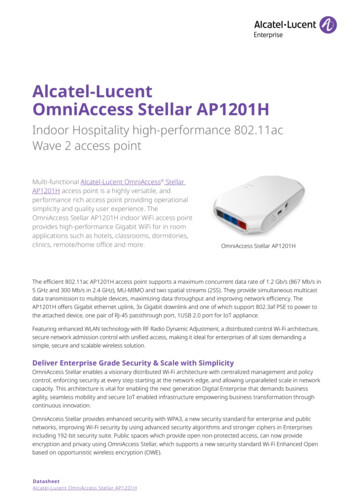
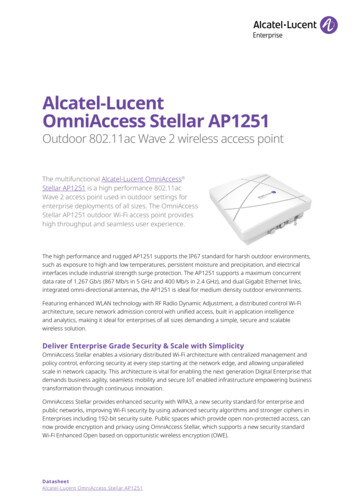
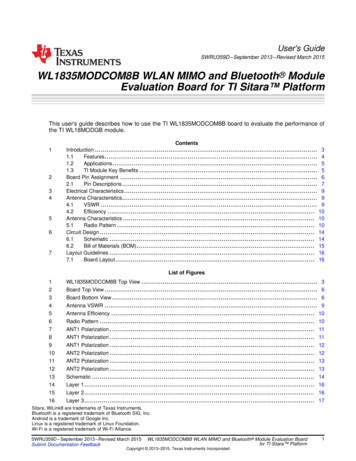
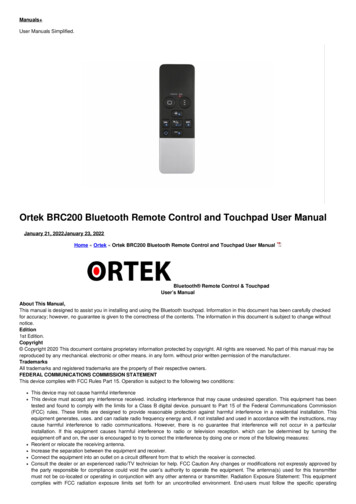
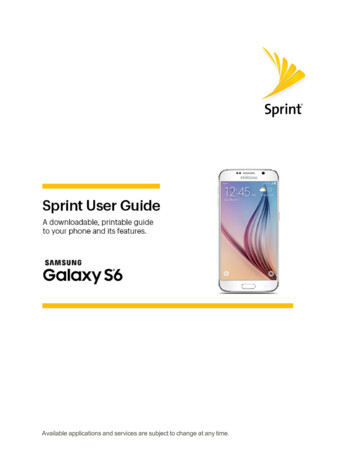

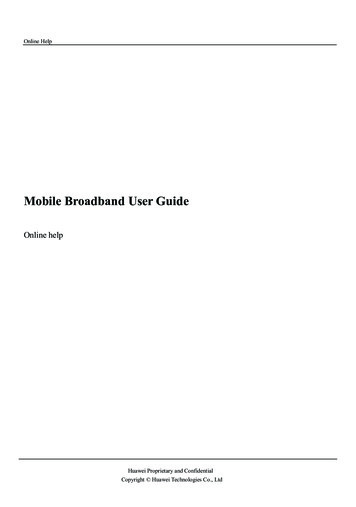
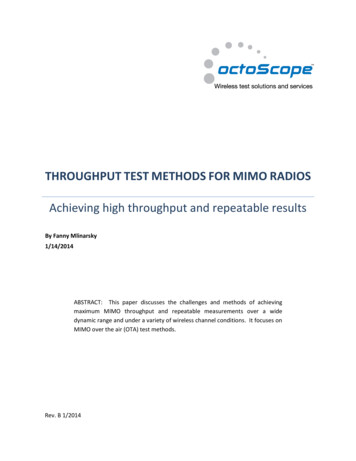
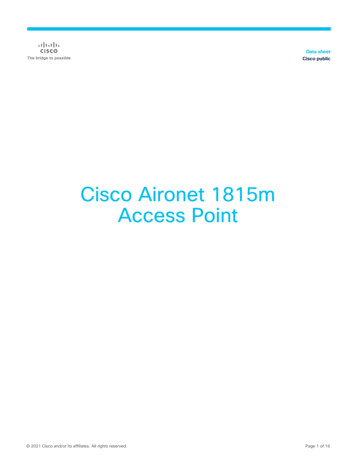
![[MS-CDP-Diff]: Connected Devices Platform Protocol Version 3](/img/35/5bms-cdp-5d-220429-diff.jpg)
